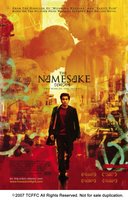
Thanks to Fox Searchlight and Faisal Irshad who successfully arranged with them to bring the film down to Raleigh-Durham, I was able to see
The Namesake at a special pre-release showing at
Galaxy Cinema (thanks to them, too!). I loved reading the book by Jhumpa Lahiri (you can read my description on
my books page), and have been looking forward to seeing this film by Mira Nair, due to be released on March 9th. I am publishing a review in
Saathee Magazine, to appear in their March issue. Below is a version of that review.
Back in 2003 days after its publication, I could hardly put down Pulitzer-winning Jhumpa Lahiri’s novel
The Namesake. Lahiri was born in London to Bengali immigrants, raised in Rhode Island, and now lives in Brooklyn. In both of her books (
The Namesake and the 2000 collection of short stories
Interpreter of Maladies, which won her the Pulitzer), she writes about the Bengali immigrant experience, particularly about families who have moved to Boston and New York.
I was therefore excited when I heard that Mira Nair would be directing a film based on the novel. Readers will probably be familiar with Nair’s films, including
Monsoon Wedding (2001),
Kama Sutra: A Tale of Love (1996),
Mississippi Masala (1991), and Oscar-nominated
Salaam Bombay! (1988); she is also in pre-production on a crime drama due out next year called
Shantaram.Mumbai-based Sooni Taraporevala, a graduate of Harvard (where she met Mira Nair) wrote the screenplay, as she also did on
Mississippi Masala and
Salaam Bombay! (incidentally, I understand that she is directing her first film, based on her own screenplay, due to be released this spring). I don’t know why, but the setting of the film version is changed from Boston and its suburbs to the New York area and moved about a decade forward.
The story is that of the Gangulis - Ashoke (Irfan Khan) and his wife Ashima (Tabu, born Tabassum Hashmi and niece of social activist and actor Shabana Azmi), Kolkata (Calcutta) immigrants to the U.S. in the early 1960s (1970s in the film), their son Gogol (Kal Penn), and his younger sister Sonali or Sonia (Sahira Nair). As a bachelor in India, Ashoke suffers terribly from a train wreck, but his life is saved because, instead of sleeping on the nighttime journey, he had been reading “The Overcoat” by Russian writer Nikolai Gogol.
When Ashoke and Ashima’s first child is born (in 1968 in the book), they are surprised that they cannot leave the hospital without naming him; they prefer to wait for the great-grandmother’s suggestion. The name of the Russian writer occurs to Ashoke, and he assigns “pet name” Gogol. The "good name" that the great-grandmother mailed never arrives, so the name Gogol sticks. As the boy grows, his name bothers him; it is neither Indian nor American, nor even a first name, and he doesn’t care to familiarize himself with anything beyond parroting that Nikolai Gogol is one of his father’s favorite authors. He legally changes his name at college to "Nikhil".
The story follows Gogol/Nikhil as he goes to Yale University, is inspired to be an architect on a family trip to India when they visit the Taj Mahal, goes to graduate school and on to a job in New York City, and experiences several romantic relationships. Wittingly or not, he follows the advice to “play the field” as much as he wishes, but to reserve marriage for a woman of Bengali origin.
How do the US-born children relate to India? Where is home for the parents and how do they stay in touch and perform their duties while geographically separated from their extended family?
The Namesake is a story of the power of a name and of family; the immigrant experience; the search for love, context, and identity.
I enjoyed the film but, as often is the case, I found it to fall short of the book, whose power made me an instant fan of Lahiri’s (watch for a cameo appearance by her in the film as Aunt Jhumpa). Armchair criticism is easy, however, and perhaps more meaningful insight is gained by asking if the medium is effectively used to convey the ethos of the story.
The answer is a gentle “yes”. One of Lahiri’s strengths as a writer is an attention to detail revealed in a matter-of-fact style that doesn’t belabor the obvious. But of course the film cannot fairly be expected to reveal all of the original’s subplots, such as Gogol’s first relationship with his college sweetheart Ruth, or the myriad details beautifully presented in the book surrounding multicultural celebrations of birthdays, for example.
The film effectively contrasts the chaotic vibrancy of Kolkata with the much more restrained and anonymous big city life of the States through foundational scenes of bridges – the Howrah Bridge over the Hooghly River and Manhattan’s 59th Street Bridge. In New York, we can see the business of modern city life rendered mute through a small apartment’s glass windows; in India, no such respite from daily life is readily found. Another effective motif is the recurrence of the
Travelogues exhibit at JFK Airport, reminding us through changing holographic images about the transition in space and culture that the Gangulis experience traveling between America and India.
There are some particularly well composed, emotive scenes, such as the timidly uncertain wave goodbye of Ashima to Ashoke on their first morning together in the New World when he leaves on dismal snowy streets for work. I wouldn’t, however, characterize the film as a whole as having consistently memorable cinematography, though it is rather effectively subtly understated and helps the story to progress.
The soundtrack could have been more appealing. Perhaps I was too focused on fidelity to the book which of course can simply be an irrelevant distraction, but I didn’t relate to the music of high school student Gogol as characteristic of either the late 1970s or late 1980s. Strictly speaking, the JFK exhibit was installed in 2000, which is inconsistent in fact and in technology with most of the trips that the Ganguli family makes through the airport starting in the 1970s.
All that said, Mira Nair has made a sensitive, touching, and very interesting film that triggers an authentic collection of emotions from joy to despair, with dashes of convincingly real everyday humor and chance. I was happy to see in the closing credits two of the three best known Bengali filmmakers mentioned, “For RITWIK GHATAK and SATYAJIT RAY, gurus of cinema with love and salaams”; only Mrinal Sen is missing.
I recommend both the film (expected to be theatrically released on March 9) and, especially, the book for first and second generation immigrants and their friends, as well as to anybody who has felt significant loss, detachment, or uncertain change in their life. It is a story that is remarkable in its subtle depiction of the flip sides of the coin of history and promise.
7 stars out of 10
Note: all pictures are copyright ©2006 by Twentieth Century Fox, and used with their permission. Photographs by Abbot Genser and Mira Nair.References:



